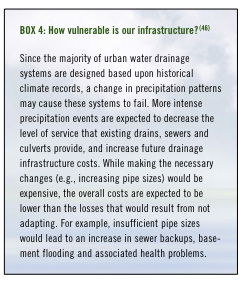| CONTENT | REFERENCES | RESOURCES | SPONSORS | CONTRIBUTORS | HOW TO USE THIS CD |
| CLIMATE CHANGE IN CONTEXT | PREVIOUS | | | NEXT |
7.2.1.d
Insurance Adaptation Measures for Climate Change
Built areas are more vulnerable to damaging infrastructure due to extremes of weather such as floods or excess snow or ice loads. Insurance on crops will be riskier due to the same extremes.

Source: H. Hengeveld et al., (2002) Science and Impacts of Climate Change CD
Presentation Graphics MSC Environment Canada/ ESS Natural Resources Canada, December.
Weather related disasters alone cost Canadians more than an average $1 billion per year.
Municipalities with aging and joint sewage /runoff lines will be higher risk, especially if close to bodies of water, as many in Ontario are. The majority of northern and southern Ontario communities were founded on or near water, not only for drinking water and sewage discharge but also as a mode of transport both as summer and winter waterways. Log drives, block ice for refrigeration, transporting goods and people, power for flour and textile mills are some of the historical uses that encouraged people to build on floodplains and on lake shores.
The Ontario Conservation Authorities – now a total of 38 – began to be formed after Hurricane Hazel in 1954. The laws now prevent building below the crest of land leading to the floodplain. Maximum flood lines – developed on the basis of the worst flooding in the last 100 years – may have to be revised upward due to the extreme weather events of climate change.
Watersheds and dams and water reservoir management policies should all reflect the worse case scenario where possible. Water damage to roads, bridges, and public buildings such as libraries and schools will prove expensive for municipalities. The damage done by flooding is increased by the warm humid conditions in buildings after floodwater’s have receded due to the increased risks of damage from the growth of molds.

ACTIVITY 1 Research the Ontario Extreme Weather Event – Flooding in Peterborough in 2004.
1. How many millions of dollars was the damage? How much rain fell in less than 2 days?
2. How many other floods have there been in Peterborough’s history?
3. What are the main reasons that Peterborough is susceptible to flooding?
4. What adaptive measures addressing extreme events are being taken in Peterborough?
Bonus: What other cities in Ontario have a similar history?
What adaptive measures have they taken?
Insurance premiums and deductibles may be higher and the coverage may be smaller due to the increase in risks. Public emergency insurance and private insurance have already begun to change their roles. The role of the emergency support from the federal government has increased. Check the ice storm and crop damage compensation for extreme events in Ontario.
Aging Infrastructure as a Factor
In the past few decades Ontario, as the rest of Canada, has spent less of its GDP on infrastructure. The age of existing infrastructure is at least an average of 25 years. Upgrading and/or designing new infrastructure* means building more than roads, bridges, or mass transit. It includes sewage, water treatment and delivery systems, and public buildings.
Retrofitting existing structures, and building for lower extremes to withstand the increase in weather loads, for example, snow load, ice loads and flooding, should be done with updated designs which consider the impacts and projections of climate change. Considering the risk of re-occurrence of extreme weather events should be part of planning for infrastructure renewal or expansion.
ACTIVITY 3 Research
1. How old are the sewer system, the water treatment and delivery system, the power system and the public buildings, such as schools, in your local municipality?
2. What emergency measures are in place for natural disasters in this municipality?
3. Where are the plans for these emergency measures? Are they available to the public?
4. What preparations should individuals make to be able to cope with these emergencies?
The proportion of the dollars spent in the chart below shows an increase in government disaster dollars over the private sector dollars. This trend will be continued with a higher frequency of extreme weather events. The ice storm caused direct damage, such as collapsing roof-sand towers, but the indirect damage was expensive – loss of frozen food, clearing of fallen trees, military presence to rescue citizens and support municipal workers all were added disaster costs.
ACTIVITY 4
1. Choose one decade and research this information for Ontario only.
2. Show the dollars in the bar graph spent by the private sector and the government sector in dealing with the disasters for this decade.
Extreme weather events such as ice storms and floods have shown that maintenance of water storage and water quality need precautionary measures now. Heavy precipitation or thawing events demand separating runoff from sewage lines. e.g. see Peterborough flood July 2004.
Public health workers, home care workers, volunteers for programs, such as Meals on Wheels and Good Neighbours, must all work together and be supported as they care for the elderly in heat stress and smog days.
Emergency measures protocols, communications, and procedures need to be in place for the protection of community health. Lessons from Walkerton water and SARS respiratory diseases should lead to implementation of preventative measures as well as emergency procedures.
Protocols should be examined to reduce the number of hospital-caused infections.
In 2004, Emergency Management Ontario (EMO) and the Meteorological Service of Canada (MSC) launched a new web site www.hazards.ca as part of the Innovation and Learning Fund initiative of Environment Canada * See “Excerpt” below. Municipalities will now be able to have more complete and standardized information to identify and respond to atmospheric hazards. This will allow municipalities to better protect their citizens from extreme weather and air quality events. It should also reduce the damage incurred by these events and hence insurance costs.
Societal factors
The size and wealth of human populations are also factors in the increasing cost of natural catastrophic losses. The size and density of the population, especially in urban areas along with property of all types is reflected in the cost of these losses. The urbanization of the province, indeed of Canada, is also reflected in the number of motor vehicles registered.
ACTIVITY 5
Find the data and graph motor vehicle registrations in Ontario for 1900-2000 as well as the urban vs rural populations in Ontario for the same period.
1. What is the relationship between increase in the urban population and the number of motor vehicles registered in Ontario from 1901 to 1999?
2. Check the development of Ontario roads in section 5.2.2c. How many kilolmeters of roads are there in Ontario in 2005?
ACTIVITY 6 Research:
Carry out the same research for the number of kilometers of railroad in the Ontario.
Responses of society to extremes of weather and to climate change will have to take into account the increase in vulnerability and value of resulting losses. Insurers project that the cost of losses is likely to continue to increase due to aging infrastructure and denser urban populations – even if the changing climate does not cause an increase in weather extremes. Climate change simply increases the risk of present vulnerability to damage. More loss reduction research is needed.
The insurance industry emphasizes the need to develop and plan strategies of reducing emissions – mitigation and reducing risk – adaptation. These plans are the best response to the challenge of reducing risk or vulnerability to these losses.
The key element for adaptation strategies is knowledge. The International Joint Commission prepared this list (Table 7) to address need for preparations for climate change.
Implications of Climate Change
Economic Activities
- Hydroelectric power generation and transmission
- Commercial navigation
- Urban development and infrastructure
- Agriculture
- Recreation and tourism
- Industry
- Forestry
Human Health
- Water quality
- Heat stress
- Air quality
- Disease and illness
Water Resources
- Drought
- Flood
- Water use
- Water quality
Ecosystems
- Vegetation
- Wetlands
- Wildlife
- Fish
Communication
- Environmental stewardship
- Local stakeholders
- High-risk populations (human health and weather extremes)
- Sustainable use of water
- Risk communication
Management
- Emergency planning, preparedness, forecasting, and disaster relief
- Watershed planning and management
- Data collection
The next steps are more difficult. Managing to meet multiple demands in a changing environment requires an integrated approach.Stakeholders and practitioners in the Great Lakes region must consult and collaborate to:
1. Assess and evaluate potential adaptation measures.
2. Choose preferred adaptation measures.
3. Develop action plans that contain a portfolio of adaptation measures and incorporate means to address barriers to adaptation.
4. Implement adaptations.
5. Monitor impacts and adaptation measures for effectiveness.
6. Reassess adaptation measures.
International Joint Commission (IJC) Climate Change and Water Quality in the Great Lakes Region. May2003 www.ijc.org
*Excerpts below are from a speech made by Angus Ross in a presentation to the Institute for Catastrophic Loss. Angus Ross Chief Agent, SOREMA N.A. June 9, 2000
REFLECTIONS ON THE FUTURE -Climate Change and its impacts on the insurance industry.
“It is probably accurate to say that the only catastrophe which has occurred in the last thirty years in Canada where a realistic estimation of insured losses has been made is the Ontario/Quebec ice storm.
I would very strongly urge there be a central repository for catastrophe loss information – and the most obvious place would be the Institute for Catastrophic Loss Reduction – to which all insurance companies licensed in the country would have to report gross and net losses following a named catastrophe.
The individual data could be kept confidential and only aggregate data released. In this fashion we would be able to provide totally accurate numbers to the government and indeed back up the push for greater government involvement in the reduction of catastrophic losses. Allied to this is the absence of catastrophe naming.
In the United States when a disaster exceeds, I believe it is $25 m, it is designated a catastrophe. At that point loss information starts to be provided. I believe that we can go somewhat further than that. We can set up a body that would not only identify the catastrophe but also define it.
Such a group would probably consist of meteorologists, seismologists and representatives from the insurance industry and representatives from the reinsurance industry. Within a short time of a catastrophe occurring we would be able to designate the exact time period for the catastrophe, whether or not it was one or two events. We would be able to then total the insured losses from the event. I think we would all benefit from the establishment of such a committee”.
Weather related disasters alone cost Canadians more than an average $1 billion per year.
Taking action now can reduce the risk of damage and the cost of insurance in the future.
Source: H. Hengeveld et al., (2002) Science and Impacts of Climate Change CD
Presentation Graphics MSC Environment Canada/ ESS Natural Resources Canada, December



